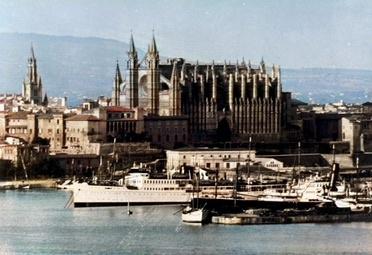How has Almudaina Palace's architecture been preserved or restored over time?
Similar Topics
almudaina palace restoration
gothic architecture preservation
moorish architectural features
14th century palace
palma de mallorca
historic stone conservation
traditional restoration techniques
spanish monarchy residence
Almudaina Palace, located in Palma de Mallorca, is a remarkable example of Gothic and Moorish architecture that has been carefully preserved and restored to maintain its historical and cultural significance. Originally constructed during the 14th century on the site of a former Moorish fortress, the palace has undergone several phases of restoration, particularly from the 20th century onwards. The Spanish government, recognizing the palace’s importance as a symbol of the region’s heritage, has overseen meticulous preservation efforts aimed at retaining its original architectural features while making the building accessible and functional for official use.
The restoration work has focused on both the exterior and interior elements, ensuring that the intricate stone facades, the elegant Gothic arches, and the traditional Moorish detailing remain intact. Skilled artisans and conservators have employed traditional techniques, using materials that match the original ones as closely as possible to preserve the authenticity of the structure. Additionally, efforts have been made to stabilize the building and prevent deterioration caused by environmental factors such as humidity and weathering, which are common challenges in preserving historic stone architecture.
Inside the palace, delicate frescoes, wooden ceilings, and ornamental tile work have been carefully restored and maintained, showcasing the rich artistic heritage of the region. While maintaining the historical ambience, modern interventions have been discreetly introduced to improve the functionality of the palace as an official residence for the Spanish monarchy during their visits to Mallorca. This balanced approach to preservation ensures that Almudaina Palace remains both a living monument and a well-preserved example of medieval architecture, reflecting its layered history and cultural significance for visitors and locals alike.
The restoration work has focused on both the exterior and interior elements, ensuring that the intricate stone facades, the elegant Gothic arches, and the traditional Moorish detailing remain intact. Skilled artisans and conservators have employed traditional techniques, using materials that match the original ones as closely as possible to preserve the authenticity of the structure. Additionally, efforts have been made to stabilize the building and prevent deterioration caused by environmental factors such as humidity and weathering, which are common challenges in preserving historic stone architecture.
Inside the palace, delicate frescoes, wooden ceilings, and ornamental tile work have been carefully restored and maintained, showcasing the rich artistic heritage of the region. While maintaining the historical ambience, modern interventions have been discreetly introduced to improve the functionality of the palace as an official residence for the Spanish monarchy during their visits to Mallorca. This balanced approach to preservation ensures that Almudaina Palace remains both a living monument and a well-preserved example of medieval architecture, reflecting its layered history and cultural significance for visitors and locals alike.
🧩 Related Questions
Related Question
How accessible is Cala de Sa Calobra during the recommended months in terms of transportation and services?
Related Question
Are there seasonal or regional variations of gluten-free or vegan ensaimadas available in Mallorca?
Related Question
How do locals perceive the nightlife and its influence on the atmosphere of s'Arenal?
